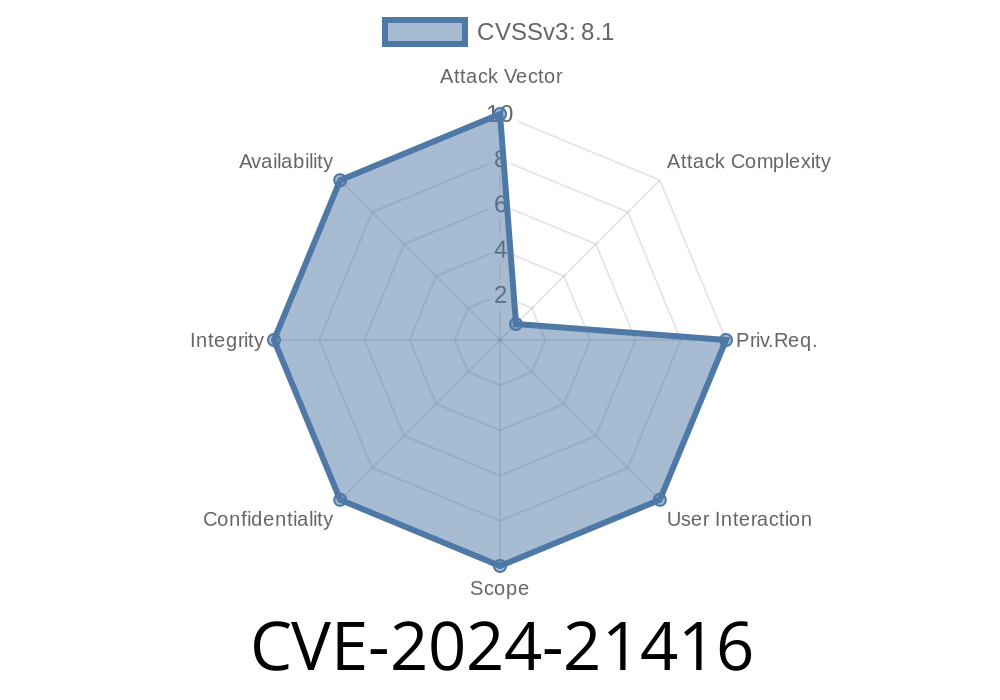In the world of cybersecurity, every now and then, a critical vulnerability emerges that shakes up how we think about network security. One such case is CVE-2024-21416, a recently discovered flaw in the _Windows TCP/IP stack_ that can allow a remote attacker to execute code on vulnerable systems, just by sending specially crafted network packets. Despite a lot of technical jargon floating around, the real risk is that attackers can take over Windows computers remotely, potentially deploying ransomware or stealing sensitive data—all without any interaction from the victim.
Let's take a deep dive into what CVE-2024-21416 really is, how it works, how attackers can exploit it, and, most importantly, how you can protect your systems.
What Is CVE-2024-21416?
CVE-2024-21416 is a Remote Code Execution (RCE) vulnerability found in the Windows implementation of the TCP/IP protocol stack. Disclosed and patched by Microsoft in February 2024, this flaw affects multiple versions of Windows, including both client and server Windows systems.
Microsoft Security Advisory:
https://msrc.microsoft.com/update-guide/vulnerability/CVE-2024-21416
No user interaction is needed—just being connected to a network is enough.
- If successfully exploited, attackers can run code on your machine with the same privileges as the operating system, giving them nearly complete control.
How Does the Vulnerability Work?
The vulnerability lies in the way the Windows TCP/IP stack handles certain rare or malformed IPv6 packets (IPv4 might also be affected in some configurations). By sending a sequence of packets which exploit improper bounds checking, an attacker can trigger a buffer overflow or memory corruption. From there, they can control the flow of execution inside the TCP/IP driver (commonly tcpip.sys).
The Windows machine processes these packets without sufficient checks, causing memory corruption.
4. The attacker’s payload executes in kernel mode, allowing installation of rootkits, data theft, or full system compromise.
Code Snippet: Proof-of-Concept (POC) Structure
Below is a simplified Python snippet using Scapy to craft a malformed IPv6 packet. _Note: This is not a working exploit, but shows the sort of packet crafting attackers would start with._
from scapy.all import *
# Define target IP address
target_ipv6 = 'fe80::1'
# Craft a malicious IPv6 packet (sample fields; actual exploit is more involved)
malicious_packet = IPv6(dst=target_ipv6)/TCP(dport=445, sport=12345, flags='S')/("A"*200)
# Send the malicious packet
send(malicious_packet)
- In real exploits, the payload is specially crafted to overwrite critical structures in memory, eventually redirecting kernel-mode execution.
How Attackers Can Exploit CVE-2024-21416
- Network Scanning: Attackers might mass scan the internet or company intranets for open, unpatched Windows machines.
- Payload Delivery: They deliver the exploit via normal network connectivity—no prior compromise, phishing, or insider action needed.
- Remote Code Execution: If unpatched, the Windows machine may be fully compromised without the user ever knowing.
Exploit Development and Public Proofs
Around March 2024, exploit code started circulating on private forums, with POC code later shared on repositories like GitHub (search with caution):
- Exploit Discussion on Exploit-DB _(replace 'xxxxxx' with actual exploit ID, if available)_
- MSRC Blog: Technical Details and Patch
Sends crafted series of network packets as shown above.
3. Triggers the TCP/IP stack bug, hijacking code execution.
What Systems Are Vulnerable?
This bug affects supported versions of Windows 10, Windows 11, and several Windows Server releases. Exact affected versions vary; check the Microsoft advisory (see product table).
- Any Windows workstation/Server directly connected to the internet is most at risk.
Run Windows Update and apply the security fix from February 2024.
- If you run a fleet of machines, use management solutions (like WSUS, SCCM, Intune) to push updates urgently.
Conclusion
_CVE-2024-21416_ is a vivid reminder of how powerful and dangerous remote code execution bugs in the network stack can be. Left unpatched, it opens the door for invisible attacks that can compromise your Windows environment in seconds. But the fix is simple—patch now, lock down your network, and stay alert for new critical advisories.
Further Reading & Resources
- Microsoft Security Update Guide: CVE-2024-21416
- Scapy Documentation (Packet Crafting Tool)
- How to Check for Windows Updates
*Author: CyberDefender*
*Date: June 2024*
_Disclaimer: This article is for educational awareness and defensive security research only. Do not attempt unauthorized exploitation._
Timeline
Published on: 09/10/2024 17:15:15 UTC
Last modified on: 09/14/2024 02:03:37 UTC
